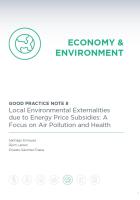Publications
This note aims to provide an overview and guidance on the use of tools to assess the environmental and health effects of changes in the levels of fine particulate matter caused by higher consumption of energy due to subsidized prices at the country level. It also provides information to help practitioners develop reliable estimates even in the absence of data and with limited resources. The topic of the note is highly complex and involves multiple fields and disciplines. The note attempts to reduce such complexity by breaking the assessment down into several distinct steps, each with its own methodologies. The note is intended to serve as a source of resources and practical advice to guide practitioners along each of these steps.
This note focuses the analysis of price subsidies on primary and secondary fine particulate matter (PM2.5, atmospheric particulate matter with a diameter of less than 2.5 microns), the pollutant with the largest health effects worldwide, and using intake fractions to estimate population exposure to PM2.5 from fossil fuels and solid biomass. This approach is like that of recent global studies of energy price subsidies and taxes. The intake fractions are combined with the relative-risk functions for major health outcomes of air pollution from the Global Burden of Disease study to estimate the health effects associated with energy price subsidies. The note proposes three geographic-demographic scales: urban areas with a population over 100,000, urban areas with a population less than 100,000, and rural areas. The note also discusses the availability of monitoring measurement data and alternative options for determining ambient PM2.5 concentrations at the proposed geographic-demographic scale, as well as approaches to deal with data scarcity. The method for estimating the economic value of mortality caused by air pollution follows a recent World Bank report, using a cross-country transfer method of the value of statistical life (VSL). In addition, the note proposes methods for incorporating valuation of increased illness, although morbidity is generally found to constitute a relatively minor share of the health costs of air pollution.
ESRAF Good Practice Overview: Guidance for Comprehensive Energy Subsidy Reforms
ESRAF Good Practice Note 1: Identifying and Quantifying Energy Subsidies
ESRAF Good Practice Note 2: Assessing the Fiscal Cost of Subsidies and Fiscal Impact of Reform
ESRAF Good Practice Note 6 to come: Identifying the Impacts of Higher Energy Prices on Firms and Industrial Competitiveness
ESRAF Good Practice Note 7: Modeling Macroeconomic Impacts and Global Externalities
ESRAF Good Practice Note 10: Designing Communication Campaigns for Energy Subsidy Reform
Enriquez, Santiago; Larsen, Bjorn; Sánchez-Triana, Ernesto. 2018. Local Environmental Externalities due to Energy Price Subsidies — A Focus on Air Pollution and Health: Energy Subsidy Reform Assessment Framework (ESRAF) Good Practice Note 8. ESMAP Paper. Washington, D.C.: World Bank Group.
